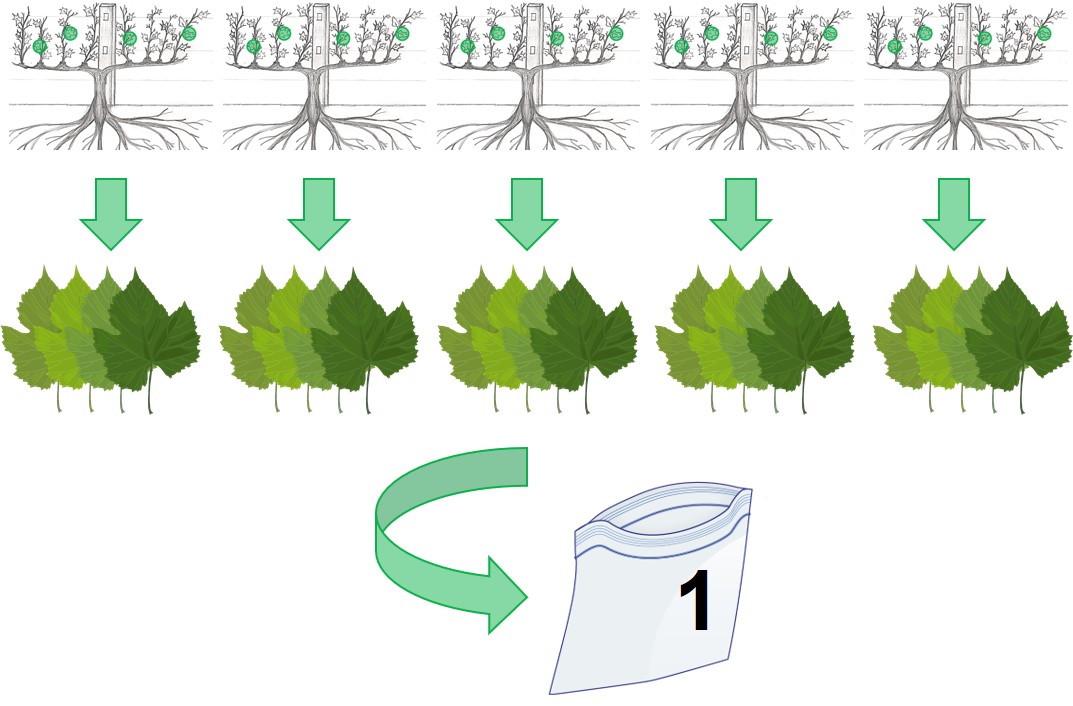Grapevine viruses

How to collect, handle and submit the ideal grape sample for virus testing
Grapevines are known to host more than 80 different species of viral pathogens. Co-infection of diverse viruses in a single vine is not uncommon and disease diagnosis based on symptom observation alone is unreliable due to the variability in the expression of symptoms and the occurrence of viral strains that cause asymptomatic infections.
When you have ruled out other plant health problems (such as trunk diseases, nutrient deficiencies and other abiotic stressors) and suspect virus infection in your vineyard, follow our recommendations to properly collect, handle, and submit the ideal grape sample for virus testing.
Sample collection
- Select suspect vines. A suspect vine is a vine with atypical growth or performance. For example, vines with discolored leaves (red/purple, yellow), leaf rolling or distortion, stunted shoots, uneven fruit ripening, and so on. We recommend flagging the vines selected for sampling as it may be necessary to re-sample and re-test.
- Label plastic bag. Using a black or blue permanent marker, label a gallon-size resealable plastic bag with your sample identifier. For example, "Chardonnay # 1". Do not use paper bags as leaf samples dry out in shipping.
- Avoid sample cross-contamination. Our testing method is very sensitive, any infected grape sap can compromise the test results of a healthy vine.
- Use disposable gloves when taking samples from more than one vine. Remember to always change your gloves before collecting samples from another vine.
- Never touch the end of detached leaves or cut cane wood.
- Collect fresh plant material. When available, collect fresh leaves with attached petioles. Do not separate the petiole from the leaf blade. After first frost, collect 1-year-old cane wood. Do not collect dead canes.
Single-vine sampling

The following are instructions on how to collect fresh leaf samples. When leaves are not available, be sure to collect four canes of at least 8 inches long.
A sample from a single vine consists of four (4) detached leaves with petioles. These leaves should be fresh and of intermediate age (not too young, not too old).
- Reach for a leaf and pull it backwards until the petiole snaps off.
- Take two (2) leaves from each cordon, making sure one comes from the front and the other from the back of the vine.
- Stack leaves on top of each other and place them inside your labeled plastic bag. Insert petioles first. Do not separate the petiole from the leaf blade.
- Push some air out of the bag and seal it. Don’t add extra moisture to the sample.
Multiple-vine sampling

When leaves are available, a sample of two, three, four, or up to five vines may be submitted for testing. This is an alternative sampling strategy to reduce testing costs. A collection of individual samples is called a composite sample.
- Samples from individual vines are collected following the same procedure described above (read "Single-vine sampling").
- Depending on the number of selected vines, a sample bag will contain a total of 8, 12, 16, or 20 leaves.
When testing cane wood, a sample of two or three vines may be submitted for testing.
- Per vine, collect two 1-year-old canes of at least 8 inches long.
- Inspect the wood; it should look green inside. Do not collect dead canes.
- Depending on the number of selected vines, a sample bag will contain a total of 4 or 6 canes.
Handling and shipping samples
Detached leaves can rapidly deteriorate, especially in warm weather. In the field and during transport, always keep samples inside a cooler with ice packs but not in direct contact, as freeze damage can occur. We highly recommend submitting samples on the same day of collection; however, samples can be refrigerated for up to 48 hours.
Before shipping your sample:
- Make sure the leaves are still crisp and fresh. If the sample is in bad condition (shriveled, dry, or rotten), we cannot test it.
- Fill out a Sample Submission Form and place it inside a separate plastic bag.
- Use a box, not an envelope, for shipping.
Please avoid shipping samples on Fridays as packages are not delivered to campus on weekends; samples will not arrive at the lab in good condition the following week.
Ship overnight (FedEx preferred) or deliver samples directly to our facility at:
MSU Plant & Pest Diagnostics
Att. Laura Miles
578 Wilson Road
East Lansing, MI 48824
Grape virus tests
Samples can be tested for the following:
- Grapevine leafroll-associated viruses (GLRaV-1, -2, and -3)*
- Grapevine red blotch virus (GRBV)
- Grapevine Pinot gris virus (GPGV)
- Grapevine fleck virus (GFkV)
- Arabis mosaic virus (ArMV)**
- Grapevine fanleaf virus (GFLV)**
- Tobacco ringspot virus (TRSV)**
- Tomato ringspot virus (ToRSV)**
Testing fees
According to the place of origin, submitted samples are charged a $20.00 in-state or $40.00 out-of-state basic submission fee.
The total fees for virus testing (per sample) are summarized in the table below.
|
Description |
Out-of-state fee |
In-state (Michigan) fee |
|
Single virus test |
$70.00 |
$50.00 |
|
* Viruses associated with grapevine leafroll disease (3 tests) |
$90.00 |
$70.00 |
|
** Nepoviruses (4 tests) |
$100.00 |
$80.00 |
|
Additional virus test run on the same sample |
$10.00 |
$10.00 |
|
All viruses (10 tests) |
$160.00 |
$140.00 |
Support provided by Project GREEEN, Michigan State Horticultural Society (MSHS), Michigan Grape and Wine Industry Council, Michigan Wine Collaborative (MWC), and Michigan Department of Agriculture and Rural Development (MDARD).
Contact us for more information!
Email: lmiles@msu.edu
Phone: 517-355-4536
Website: www.pestid.msu.edu



 Print
Print Email
Email